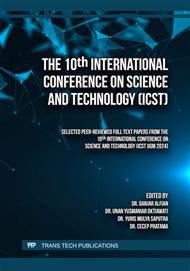[1]
T.P. Lambrou, C.C. Anastasiou, C.G. Panayiotou, M.M. Polycarpou, A Low-Cost Sensor Network for Real-Time Monitoring and Contamination Detection in Drinking Water Distribution Systems, IEEE Sens. J. 14 (2014) 2765-2772.
DOI: 10.1109/jsen.2014.2316414
Google Scholar
[2]
T.P. Lambrou, C.C. Anastasiou, C.G. Panayiotou, A nephelometric turbidity system for monitoring residential drinking water quality, in: Sensor Networks Applications, Experimentation and Logistics, Springer-Verlag, New York, 2009, pp.43-55.
DOI: 10.1007/978-3-642-11870-8_4
Google Scholar
[3]
A. Aisopou, I. Stoianov, N. Graham, In-pipe water quality monitoring in water supply systems under steady and unsteady state flow conditions: A quantitative assessment, Water Res. 46 (2012) 235-246.
DOI: 10.1016/j.watres.2011.10.058
Google Scholar
[4]
Anonim, Regulation of the Minister of Health of the Republic of Indonesia Number 492/MENKES/PER/IV/2010, Minister of Health of the Republic of Indonesia, 2010.
Google Scholar
[5]
J. Gubbi, R. Buyya, S. Marusic, M. Palaniswami, Internet of Things (IoT): A vision, architectural elements, and future directions, Future Gener. Comput. Syst. 29 (2013) 1645-1660.
DOI: 10.1016/j.future.2013.01.010
Google Scholar
[6]
M.A.A. da Cruz, J.J.P.C. Rodrigues, J. Al-Muhtadi, V.V. Korotaev, V.H.C. de Albuquerque, A Reference Model for Internet of Things Middleware, IEEE Internet Things J. 5 (2018) 871-883.
DOI: 10.1109/jiot.2018.2796561
Google Scholar
[7]
S. Chopade, H.P. Gupta, R. Mishra, P. Kumari, T. Dutta, An Energy-Efficient River Water Pollution Monitoring System in Internet of Things, IEEE Trans. Green Commun. Netw. 5 (2021) 793-702.
DOI: 10.1109/tgcn.2021.3062470
Google Scholar
[8]
M. Kumar, T. Singh, M.K. Maurya, A. Shivhare, A. Raut, P.K. Singh, Quality Assessment and Monitoring of River Water Using IoT Infrastructure, IEEE Internet Things J. 10 (2023) 10280-10290.
DOI: 10.1109/jiot.2023.3238123
Google Scholar
[9]
L.K. Baghel, S. Gautam, V.K. Malav, S. Kumar, TEMPSENSE: LoRa Enabled Integrated Sensing and Localization Solution for Water Quality Monitoring, IEEE Trans. Instrum. Meas. 71 (2022) 95-98.
DOI: 10.1109/tim.2022.3175059
Google Scholar
[10]
H. Sui, G. Zheng, J. Zhou, H. Li, Z. Gu, Application of NB-IoT technology in city open water monitoring, in: Proc. 6th Int. Symp. Syst. Softw. Rel. (ISSSR), Chengdu, China, 2020, IEEE, pp.95-98.
DOI: 10.1109/isssr51244.2020.00023
Google Scholar
[11]
C. Correa, D. Dujovne, F. Bolano, Design and Implementation of an Embedded Edge-Processing Water Quality Monitoring System for Underground Waters, IEEE Embed. Syst. Lett. 15 (2023) 81-84.
DOI: 10.1109/les.2022.3184925
Google Scholar
[12]
A.C.D. Junior, R. Munoz, A.V.L. Neto, M.M. Hassan, V.H.C. de Albuquerque, Internet of Water Things: A Remote Raw Water Monitoring and Control System, IEEE Access 9 (2021) 35790-35800.
DOI: 10.1109/access.2021.3062094
Google Scholar
[13]
A.A. Chowdhury, Y. Arafat, M.A. Alam, IoT-GSM Based Controlling and Monitoring System to Prevent Water Wastage, Water Leakage, and Pollution in the Water Supply, in: Proc. Int. Conf. Innov. Sci. Eng. Technol. (ICISET), Chittagong, Bangladesh, 2022, IEEE, pp.567-572.
DOI: 10.1109/iciset54810.2022.9775876
Google Scholar
[14]
B. Siregar, K. Menen, S. Efendy, U. Andayani, N. Rakesh, Monitoring Quality Standard of Waste Water using Wireless Sensor Network Technology for Smart Environment, in: Proc. 2nd Int. Conf. I-SMAC IoT Soc. Mobile Anal. Cloud (I-SMAC), Tangerang, Indonesia, 2018, IEEE, pp.168-173.
DOI: 10.1109/i-smac.2018.8653773
Google Scholar
[15]
B.A. Aderemi, T.O. Olwal, J.M. Ndambuki, S.S. Rwanga, A review of groundwater management models with a focus on IoT based systems, Sustainability 14 (2022) 148.
DOI: 10.3390/su14010148
Google Scholar
[16]
Y.J. Yong, et al., Toward industrial revolution 4.0: Development, validation, and application of 3D-printed IoT-based water quality monitoring system, J. Clean. Prod. 324 (2021).
Google Scholar
[17]
A.O. Nurshanty, A. Saputra, F.R. Hardjanto, M.B. Franklyn, D. Yudanegara, I.K. WAIROOY, Teknik Dalam White-box dan Black-box Testing, https://socs.binus.ac.id/2020/07/02/teknik-dalam-white-box-dan-black-box-testing, 2020, Accessed: 2020-08-01.
DOI: 10.1017/9781108974073.011
Google Scholar


